

React 特性剪辑(版本 16.0 ~ 16.9)
source link: https://zhuanlan.zhihu.com/p/51677988
Go to the source link to view the article. You can view the picture content, updated content and better typesetting reading experience. If the link is broken, please click the button below to view the snapshot at that time.

React 特性剪辑(版本 16.0 ~ 16.9)
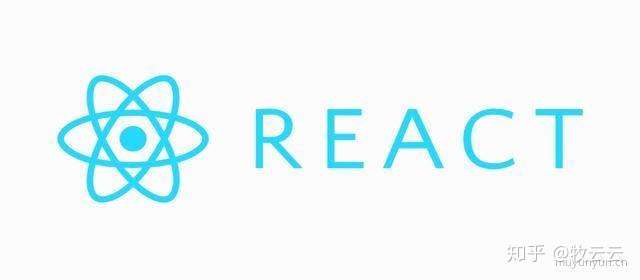
Before you're going to hate it, then you're going to love it.
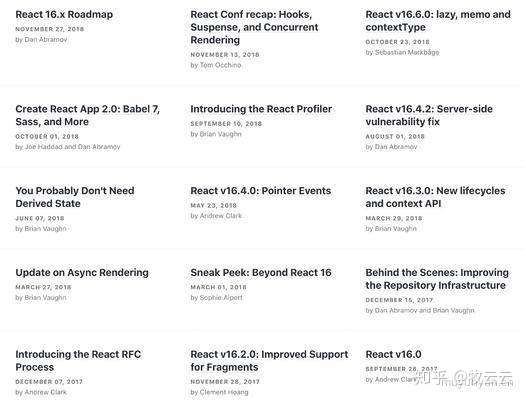
Concurrent Render(贯穿 16)
在 18年的 JSConf Iceland 上, Dan 神提到 Concurrent Render 涉及到 CPU 以及 IO 这两方面。
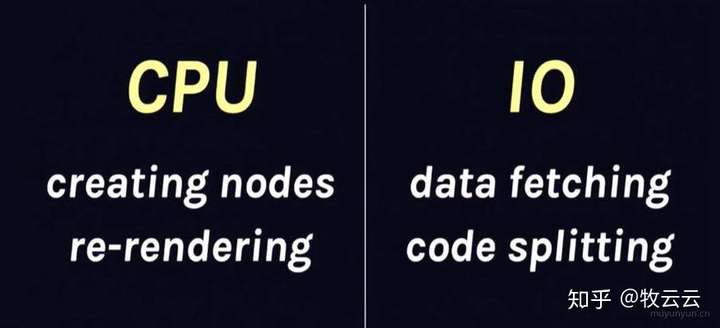
Time Slicing 对应解决左侧的问题, Suspense 对应解决了右侧的问题。它们共同要解决的是的提升用户体验, 在更多的场景下都可以做到可交互。而 Fiber 架构是上述两者的基石。
Time Slicing
在 16 之前的版本的渲染过程可以想象成一次性潜水 30 米,在这期间做不了其它事情(Stack Reconciler);
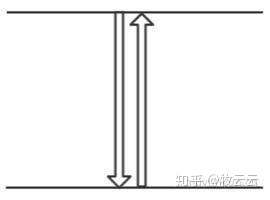
痛点概括:
- 一次性渲染到底
- 中途遇到优先级更高的事件无法调整相应的顺序
接着拿上面的潜水例子为例,现在变为可以每次潜 10 米,分 3 个 chunk 进行; chunk 和 chunk 之间通过链表连接; chunk 间插入优先级更高的任务, 先前的任务被抛弃。
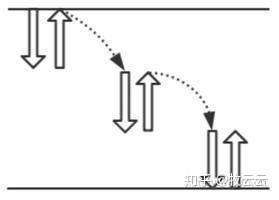
开启 Fiber 后,获取异步数据的方法应放到 render 后面的生命周期钩子里(phase 2 阶段)进行, 因为 render 前面的生命周期钩子(phase 1阶段)会被执行多次
注意: 并没有缩短原先组件的渲染时间(甚至还加长了),但用户却能感觉操作变流畅了。
requestIdleCallback(): 借力此 api, 浏览器能在空闲的时间处理低优先级的事。
Suspense(16.6, 16.8, 16.9)
Suspense 意思是能暂停当前组件的渲染, 当完成某件事以后再继续渲染。
- code splitting(16.6, 已上线): 文件懒加载。在此之前的实现方式是 react-loadable
- 并发模式(16.8, 2019 年 Q2 季度): 在文件懒加载的同时能做其它交互;
- data fetching(16.9 版本, 2019 年中): 数据动态呈现;
import React, { lazy, Suspense } from 'react'
const OtherComponent = lazy(() => import('./OtherComponent'))
function MyComponent() {
return (
<Suspense fallback={<div>loading...</div>}>
<OtherComponent />
</Suspense>
)
}一种简单的预加载思路, 可参考 preload
const OtherComponentPromise = import('./OtherComponent');
const OtherComponent = React.lazy(() => OtherComponentPromise);render 新增的返回类型
在 React16 版本中 render() 增加了一些返回类型,到目前为止支持的返回类型如下:
- React elements.
- Arrays and fragments.
- Portals.
- String and numbers.
- Booleans or null.
其中 render() 支持返回 Arrays 能让我们少写一个父节点, 如下所示:
const renderArray = () => [
<div key="A">A</div>
<div key="B">B</div>
]render() 支持返回数组的特性类似 Fragments(16.2), 使用 Fragments 可以不用写 key。
Portals(传送门)
将 React 子节点渲染到指定的节点上
案例:实现一个 Modal 组件,demo
另外关于 Portals 做到冒泡到父节点的兄弟节点这个现象, demo, 我想可以这样子实现:如果组件返回是 Portal 对象,则将该组件的父组件的上的事件 copy 到该组件上。其实并不是真的冒泡到了父节点的兄弟节点上。
Error Boundaries
React 16 提供了一个新的错误捕获钩子 componentDidCatch(error, errorInfo), 它能将子组件生命周期里所抛出的错误捕获, 防止页面全局崩溃。demo
componentDidCatch 并不会捕获以下几种错误
- 事件机制抛出的错误(事件里的错误并不会影响渲染)
- Error Boundaries 自身抛出的错误
- 异步产生的错误
- 服务端渲染
服务端渲染
服务端渲染一般是作为最后的优化手段, 这里浅显(缺乏经验)谈下 React 16 在其上的优化。
在 React 16 版本中引入了 React.hydrate(), 它的作用主要是将相关的事件注水进 html 页面中, 同时会比较前端生成的 html 和服务端传到前端的 html 的文本内容的差异, 如果两者不一致将前端产生的文本内容替换服务端生成的(忽略属性)。
支持自定义属性
在 React 16 版本中, 支持自定义属性(推荐 data-xxx), 因而 React 可以少维护一份 attribute 白名单, 这也是 React 16 体积减少的一个重要因素。
Context(16.3、16.6)
Context 相当于是用组件化的方式使用 global, 使用其可以共享认证的用户、首选语言(国际化)等一些全局的信息, 而不必通过组件一层层传递。
以下是比较冗余的传递:
<Page riderId={riderId} />
// ... which renders ...
<RiderDetail riderId={riderId} />
// ... which renders ...
<RiderLevel riderId={riderId} />
// ... which renders ...
<Avatar riderId={riderId} />在 Context 之前可以传递 <Avatar> 本身(Component Composition 的思想), 写法如下:
function Page(props) {
const avatar = <Avatar riderId={props.riderId} />
return <RiderDetail avatar={avatar} />
}
<Page riderId={riderId} />
// ... which renders ...
<RiderDetail avatar={avatar} />
// ... which renders ...
<RiderLevel avatar={avatar} />
// ... which renders ...
{ props.avatar }接着是使用 Context 书写的例子, 写法如下:
const RiderContext = React.createContext(1) // 这里为默认值
function Page(props) {
const riderId = props.riderId
return (
<RiderContext.Provider value={riderId}>
<RiderDetail />
</RiderContext.Provider>
)
}
function RiderDetail() {
return <RiderLevel />
}
class RiderLevel extends React.Component {
static contextType = RiderContext
render() {
return <Avatar avatar={this.context} />;
}
}新的生命周期(16.3)
在未来 17 的版本中,将移除的生命周期钩子如下:
componentWillMount(): 移除这个 api 基于以下两点考虑:- 服务端渲染: 在服务端渲染的情景下, componentWillMount 执行完立马执行 render 会导致 componentWillMount 里面执行的方法(获取数据, 订阅事件) 并不一定执行完;
- Concurrent Render: 在 fiber 架构下, render 前的钩子会被多次调用, 在 componentWillMount 里执行订阅事件就会产生内存泄漏;
迁移思路, 将以前写在
componentWillMount的获取数据、时间订阅的方法写进componentDidMount中;
componentWillReceiveProps(nextProps): 移除这个 api 基于如下考虑:- 语义不太契合逻辑
举个例子: 比如切换 tab 时都要重新获取当前页面的数据, 之前通常会这么做:
componentWillReceiveProps(nextProps) {
if (nextProps.riderId !== this.props.riderId) {
fetchData()
}
}新的钩子 getDerivedStateFromProps() 更加纯粹, 它做的事情是将新传进来的属性和当前的状态值进行对比, 若不一致则更新当前的状态。之前 componentWillReceiveProps() 里的获取数据的逻辑之前提到 Concurrent render 的时候也提到了应该后置到 componentDidUpdate() 中。
getDerivedStateFromProps(nextProps, prevState) {
if (nextProps.riderId !== prevState.riderId) {
return {
riderId: nextProps.riderId
}
}
// 返回 null 则表示 state 不用作更新
return null
}componentWillUpdate(): 目前将其理解为和componentWillMount一样的情况
在 React 16.3 的版本中,新加入了两个生命周期:
getDerivedStateFromProps(nextProps, prevState): 更加语义化, 用来替代componentWillMount()和componentWillReceiveProps(nextProps);getSnapshotBeforeUpdate(prevProps, prevState): 可以将该钩子返回的结果传入 componentDidUpdate 的第三个参数中, 从而达到 dom 数据统一。用来替代 componentWillUpdate();
具体 demo 可见 Update on Async Rendering
React.memo(16.6)
React.memo 是一个高阶组件, 它使无状态组件拥有有状态组价中的 shouldComponentUpdate() 以及 PureComponent 的能力。
const MyComponent = React.memo(function MyComponent(props) {
...
})Hooks(16.7)
在 React 16.7 之前,React 有两种形式的组件,有状态组件(类)和无状态组件(函数)。Hooks 的意义就是赋能先前的无状态组件,让之变为有状态。这样一来更加契合了 React 所推崇的函数式编程。
接下来梳理 Hooks 中最核心的 2 个 api, useState 和 useEffect
useState
useState 返回状态和一个更新状态的函数
const [count, setCount] = useState(initialState)使用 Hooks 相比之前用 class 的写法最直观的感受是更为简洁
function App() {
const [count, setCount] = useState(0)
return (
<div>
<p>You clicked {count} times</p>
<button onClick={() => setCount(count + 1)}>
Click me
</button>
</div>
)
}useEffect(fn)
在每次 render 后都会执行这个钩子。可以将它当成是 componentDidMount、componentDidUpdate、componentWillUnmount 的合集。因此使用 useEffect 比之前优越的地方在于:
- 可以避免在
componentDidMount、componentDidUpdate书写重复的代码; - 可以将关联逻辑写进一个
useEffect;(在以前得写进不同生命周期里);
React 的未来
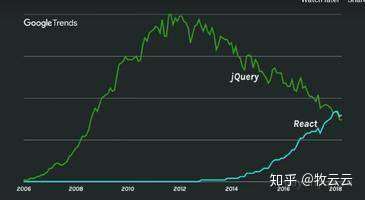
今年的 React Conf 的一张图, 可以看到 React 从出来到现在势头呈稳健上升趋势, 并在 2018 年这个节点上把 Jquery 拉下了王座。但可以看见 React 未来还有一段很长的路要走。
Recommend
About Joyk
Aggregate valuable and interesting links.
Joyk means Joy of geeK